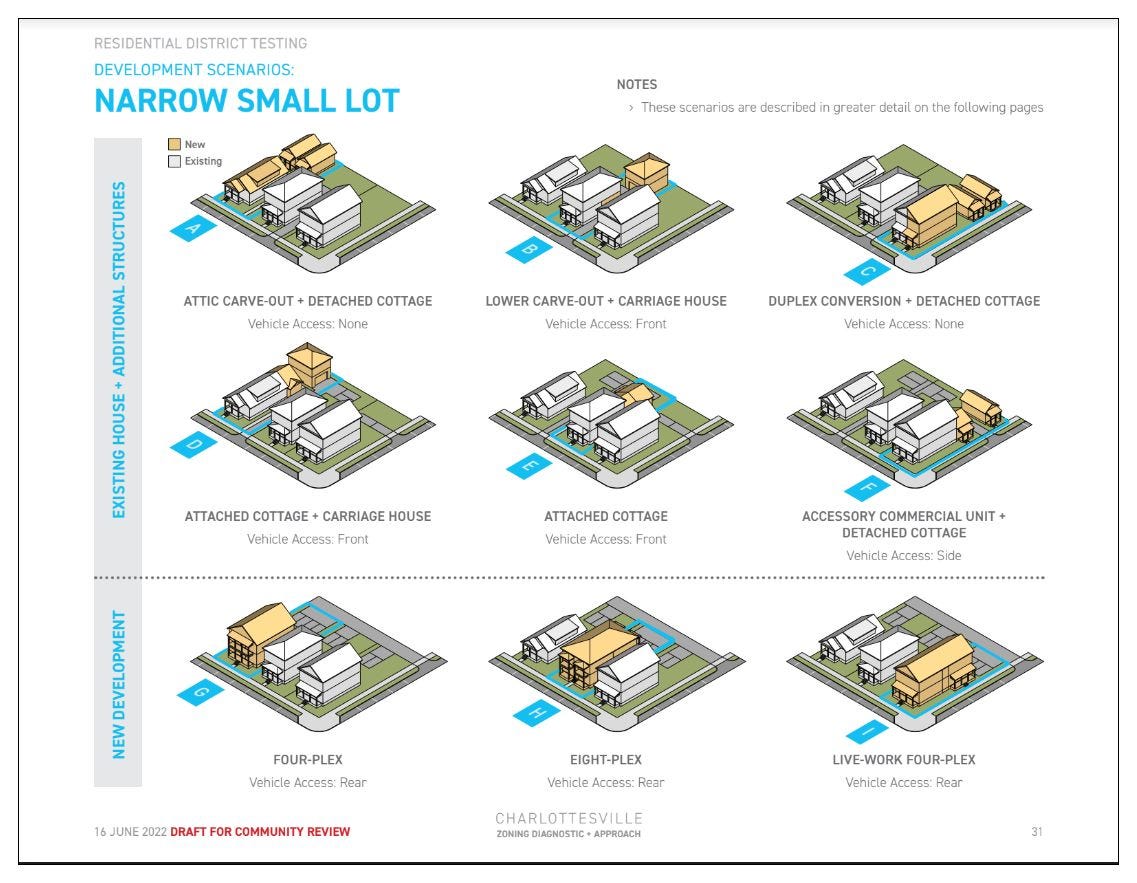June 2022 property transactions: Over a hundred summaries of real estate activity in a market that continues to rise in value
This is the 18th installment of an anecdotal review intended to educate myself and others during a time when the rules are changing
For the transactions, go straight to the bottom. Let’s start with some backstory about the land use policy changes that are currently underway.
This summer, Charlottesville community members are encouraged to participate in the third act of the Cville Plans Together initiative. The city and the consultants have published the Zoning Diagnostic and Approach Report which describes how the ordinance will be changed to make it easier for developers to develop more units.
“This plan acknowledges the negative legacies planning and zoning have had and how they have been used to divide, exclude, and diminish communities of color and historically marginalized communities,” Neighborhood Development Services Director James Freas writes in an introduction to the report. “Frequently, the tools of planning and zoning were used to either advance-large scale change or prevent it entirely.”
The already approved Affordable Housing Plan and Comprehensive Plan are intended to advance large-scale change. Now the zoning is intended to make it easier to build by eliminating the City Council and Planning Commission’s role in making most land use decisions. That is intended to lower the costs of development.
In February of 2019, a previous Council decided to put out the call for a consultant to work on all three plans when the Comprehensive Plan review reached an impasse over disputes over the Future Land Use Map.
A request for proposals issued in June 2019 put racial equity at the heart of the work.
“In Charlottesville’s history, the failure of institutions and city government to be accountable to low-wealth communities, particularly communities of color, has taken many forms: violent suppression, structural oppression, neglect, half-hearted or insincere attempts that serve to manufacture consent, and well-meaning attempts that end up failing due to their assumptions, framework, and processes favoring those in power and resulting in lopsided and inaccurate information, community inaction, or community harm,” reads the fifth paragraph of the request for proposals.
In his letter, Freas refers to recommendations on page 77 of the Affordable Housing Plan.
Increase access to opportunity: Land use policies should create more housing in areas of opportunity such as near main transit lines, jobs, or in mixed-income neighborhoods, but must also be designed to prevent displacement of low-income residents due to increased investment and rising housing costs.
Redress racial segregation: Historically, land use policies across the U.S. have used overtly racist covenants to deny homebuying opportunities to non-white Americans. Single-family zoning is a reflection of this practice. Revising single-family zoning to increase the supply of affordably priced housing in areas of opportunity is a critical step to undoing the legacy of racial segregation and entrenched wealth inequities.
Increase housing supply to limit market pressure on rents and home prices: The City of Charlottesville and Albemarle County are expected to add 15,000 households by 2040.Housing prices are growing rapidly as demand exceeds supply: The region must build more housing to prevent pricing pressure, and to ensure that residents have equitable options to access schools, access jobs, and age in place.
Support affordability without additional demands on local funding Land use tools can allow cities to influence the quantity, location, and affordability of housing without needing to monetarily subsidize new development. Decreasing development costs and increasing density increase the financial feasibility of developing both market-rate and affordable housing—especially in areas of opportunity.
How will this translate into change?
One goal of the Zoning Diagnostic and Approach report is to demonstrate how each lot type in the city could be developed. There are narrow lots and there are wide lots, and the report breaks down the many different variations.
The “narrow-small” category describes most of 10th and Page, Belmont, Ridge Street, Rose Hill, and Starr Hill. The “narrow-medium” and “narrow-medium double” can be found in Fifeville, Martha Jefferson, North Downtown, and Woolen Mills.
The “wide-medium” category can be found in Fry’s Spring, Johnson Village, and Locust Grove. “Wide-large” shows up in Barracks / Rugby, Jefferson Park Avenue, and Venable. Greenbrier, Lewis Mountain, and the Meadows are neighborhoods representative of the “Wide-xlarge” category.
The zoning report also explains different housing types, with one defined as “existing house” which assumes a landowner would want to keep the structure. The others are “house-scale plexes,” “mid-scale plexes,” and townhouses.

The work of the draft ordinance is not complete, but I believe these terms should be learned by anyone with an interest in this topic. The staff recommendation is to “modify” existing setback requirements, reduce or remove parking requirements, and to allow smaller lots to allow more of a building footprint than currently allowed.
Some questions:
While the plan is drafted, what’s happening now in Charlottesville’s property market?
What if anything is being done to make sure that those who are choosing to sell their property are aware that the zoning to come will come with more potential development?
Will the people who already know how to work the system benefit more than people who do not know how it works?
Does the city have the capacity to hire enough people to do the work to track the affordability that is intended to be created?
Anyway, on to the numbers.
Read the rules from last month to get a sense of how these transaction reports work. This time around I am putting the Future Land Use Map designation as well as the zoning, unless the unit is a condominium. I’ll leave it to you to look up the lot type.
This will be posted on Information Charlottesville in a few days. Paid subscribers to Charlottesville Community Engagement get a first look. Please consider a subscription so I can keep doing this work as the process continues. This is the 18th installment of this. What will this place look like when we get to the 81st?



